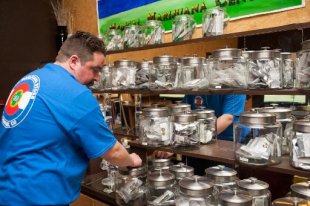
Sam Walsh, a ‘budtender’, sets up marijuana products as the 3-D Denver Discrete Dispensary prepares to open for retail sales on January 1, 2014 in Denver, Colorado
The standard debate about marijuana legalization has been “Should we, or shouldn’t we?” For better and for worse, the country appears to be moving toward answering that question in the affirmative. The next logical question is, or ought to be, “What sorts of organizations do we want to supply that legal marijuana?
The debate typically skips past that crucial question and presumes that legal cannabis will be produced and sold by for-profit companies—with the government setting some regulatory limits such as restricting access to minors. Colorado and Washington, the two states where voters have already approved legalization, have gone this commercial route.
At first glance, it doesn’t seem so bad. After all, the companies that have obtained licenses to produce or sell marijuana in Colorado, and the quasi-legal medical marijuana dispensaries that operate in a number of states, seem quaint and countercultural right now—hippies enjoying a nice middle-class lifestyle clucking over little plots with fifty or a hundred plants. But such mom-and-pop operations aren’t likely to last.
Cannabis is just a plant. If cannabis production ends up looking anything like modern agriculture, these small, independent operations will be shunted aside by bigger, professional farms. And if cannabis distribution looks anything like distribution of other consumer goods, those farms will supply companies that use marketing savvy to develop and exploit brand equity. These more organized enterprises will be driven by profit and shareholders’ interests, not concern for public health or countercultural values. And as these companies grow, they’ll begin to wield considerable political power. (Note that even the current legal cannabis industry, in its infancy, already has trade associations, lobbies, and holds annual conventions.)
While a few small firms may adroitly adapt to a low-volume, high-touch niche market serving primo brands to college-educated connoisseurs—akin to microbreweries—a larger, corporate reality looms. With 60 percent of marijuana being used by people with a high school education or less, we should expect the majority of consumers to shop for value: they’ll seek Walmart-style everyday low prices, not boutique ambience at boutique prices.
So if we want to avoid a legal cannabis market dominated by large companies that push to sell as much as possible to as many people as possible, then what do we do? How do we design a legal market that protects public health and limits drug abuse?
The most effective model, as Mark Kleiman explains, may be restricting sales to government-owned and -run stores. Right now, that is at best a long shot. Marijuana is still prohibited under federal law, and a state law involving the state government directly in the trade would likely be preempted by the Controlled Substances Act. Even if the federal laws do change, government stores may be political nonstarters, hated by both moral conservatives and libertarians alike. There are two other models, however, that could work. One restricts production and sale to nonprofit organizations. The other restricts production and sale to small user co-ops.
Model 1: The legalization of nonprofit production and sale
Entrusting the supply of sensitive commodities or services to nonprofits—such as blood banks, credit unions, art museums, and so on—is not new. Indeed, a good chunk of economic activity in the United States is conducted by organizations that are neither government nor for-profit enterprises.
Of course, simply designating an organization as a nonprofit doesn’t guarantee that it won’t be self-aggrandizing and politically powerful. (Nonprofit hospitals and universities, for example, compete aggressively, though they are typically more restrained by ethical principles than are corporations.) But in the nonprofit arena one can do more to guard against those tendencies. For example, a nonprofit seeking a marijuana license could be required to have a board of trustees whose members are selected by child welfare and public health agencies. The state could require that any licensee’s charter documents (e.g., its articles of incorporation or bylaws) pledge that it operate in ways that meet demand but eschew promotion, and stipulate that all excess net operating revenues be donated to drug prevention, treatment, or other charitable causes related to substance abuse.
Placing the cannabis industry in the hands of nonprofits committed to fostering public health would rejigger the incentive structure. For-profit corporations seek to grow sales and, as with alcohol and tobacco, the greatest revenues come from the most vulnerable populations; 40 percent of past-month marijuana users today meet clinical guidelines for substance abuse or dependence (on marijuana, alcohol, and/or some other substance). Nonprofits, by design, operate under different prerogatives. They are not inherently interested in expanding sales or streamlining production, since their mission is to serve the public interest, not to maximize shareholders’ profits.
The usual knock against nonprofits is that they do not operate as efficiently as do for-profit businesses. But that hardly matters, because after legalization marijuana production costs will be very low. A typical heavy user can be supplied annually by three square feet of greenhouse space (at forty grams per harvest, four harvests per year), and professional farmers’ annual costs for comparable crops run between $5 and $20 per square foot. Outdoor farming would be even cheaper; all of the marijuana currently consumed in the U.S. each year could be produced on about 10,000 to 15,000 acres—or about a dozen modest Midwest farms.
Production costs today are high because growing is done by two entities: criminal organizations, whose comparative advantage is avoiding enforcement, not practicing agronomy; and by plant-loving aficionados supplying medical dispensaries and other high-end markets from artisanal operations. A decade or so down the road, when the for-profit marijuana farming sector approaches the efficiency of tomato or pepper farmers, the production cost for a joint’s worth of basic, high-potency intoxicant, which runs about $4 today, will drop to about a nickel.
The challenge under a system of legal availability is therefore not achieving greater efficiency and lower prices but, rather, keeping prices from falling too far, since low prices are not good for public health. Multiple studies have shown that consumption rises as price falls. Consumption may be especially price sensitive among heavy users, because marijuana now takes a bigger share of their personal budgets, and among cash-strapped teenagers: two groups whose consumption we’d prefer to see go down, not up.
Low prices also undercut revenues from taxes that are assessed as a percentage of value, as in Colorado and Washington. While nonprofits would not pay corporate income or property taxes, their products would be subject to excise and sales taxes, and employees’ wages would be taxable. (Bringing employees’ wages above the table might generate roughly as much tax revenue as will the sales and excise taxes, something the debate often overlooks.)
Restricting production and sale to nonprofits also solves the problem of how to allow production without also allowing aggressive marketing, including promotions that appeal to youth, such as the Joe Camel campaign or alcopops. It’s very difficult to limit commercial entities’ advertising and other promotional efforts, since they enjoy constitutional protections as “commercial free speech.” (Most restrictions on alcohol and tobacco advertising come from voluntary restrictions, negotiated agreements, and lawsuits, not legislation, which helps explain why they are so weak.)
Placing the industry in the hands of public health-minded nonprofits sidesteps the problem of overzealous promotion, because their interests would be aligned with social welfare, not with shareholders. Big Tobacco and Big Alcohol court youth because it is the only way they can grow, and growth is in their DNA. Nonprofits operate under different incentive structures.
Model 2: Co-ops
Another option would be to restrict production and distribution to user co-ops. The co-op model might be described as “grow-your-own plus share-with-others.” Alaska effectively legalized grow-your-own when its supreme court ruled that growing up to twenty-five plants was protected by the state constitution’s privacy rights, and Colorado’s 2012 proposition, in addition to legalizing large-scale commercial production, allows any adult to grow up to six plants.
One issue with grow-your-own, however, is that not everyone has the time, inkling, or skill to grow marijuana. While growing marijuana would not challenge a professional farmer, it is trickier than growing carrots, and it suffers from the zucchini problem. One productive plant produces more than the average user can consume, but one plant that dies produces nothing. So grow-your-own is feast or famine. Furthermore, some users like variety, and they may not be able to grow all of the strains they would like to consume. Co-ops solve that problem by allowing each registered member to grow one plant or grant that growing right to another member. Members could share or trade within the co-op. Someone who grew Cannabis indica, for example, could swap with someone who grew Cannabis sativa. Someone whose plant thrived might give some of the product to a member whose plant died, knowing that the shoe might be on the other foot after the next harvest. Co-ops would be small, perhaps restricted to 100 members (and thus 100 plants total), enough to overcome the problems of grow-your-own but not enough to allow large-scale production.
Uruguay, which recently became the first country to legalize the production, sale, and use of marijuana, allows such co-ops, or “clubs.” Spain has allowed them too, for quite some time. (Spain’s laws criminalize the sale but not the possession, so sharing falls in a legal gray area.)
The co-op model would not offer all the advantages of full-blown legalization. It would not generate tax revenue, and its small scale and informal nature would leave production looking much like it does today for medical-grade marijuana—a relatively inefficient activity providing handcrafted products. Co-ops might also produce a narrower range of traditional products, like smokable marijuana and simple edibles, but not necessarily candies, bath oils, and highly concentrated forms such as butane hash oil.
Nevertheless, permitting co-ops could take a sizable bite out of the black market. More than half of marijuana users already report that they most recently obtained marijuana for free or by sharing. Others paid, but bought from friends or family. Just 7 percent reported buying from someone other than a friend, relative, or family member. So retail marijuana distribution already operates via an informal co-op model. Shifting to a formal co-op system would simply mean that product would come from co-ops, rather than black market criminal operations.
There is a spectrum of options for legal supply, ranging from none (prohibition with no medical exception) to for-profit enterprise subject only to standard business regulations. The pros and cons of the extreme positions have been well discussed. Prohibition produces black markets, arrests, and imprisonment; private enterprise promotes greater consumption in all forms, including greater abuse.
Colorado and Washington have chosen to swing from close to one end of the spectrum (prohibition except for a quite permissive medical system) to close to the other end (for-profit enterprise subject to standard regulations plus some regulations particular to marijuana). They have skipped over several viable intermediate alternatives.
Allowing organizations to produce, distribute, and sell marijuana but restricting that privilege to nonprofits is better than the Colorado and Washington strategies in almost every respect. In fact, the only people who should prefer commercial marijuana enterprises are those who themselves hope to make millions operating businesses, or hardcore libertarians who don’t believe that government should interfere in a consumer’s right to harm himself through his own bad choices.
And there may be wisdom in moving incrementally. States that jump all the way to the commercial version of legalization will have a hard time stepping back to a nonprofit or co-op model. Once a legal industry becomes entrenched, and has lobbying clout, it will be very hard to uproot. Likewise, a state monopoly model, favored by many experts, will only become an option after national legalization if there is not already an established commercial interest that would fight it. Unless voters are certain that they want for-profit businesses to control the marijuana trade, it would make sense to legalize the industry with one of these intermediate models, at least at first.















